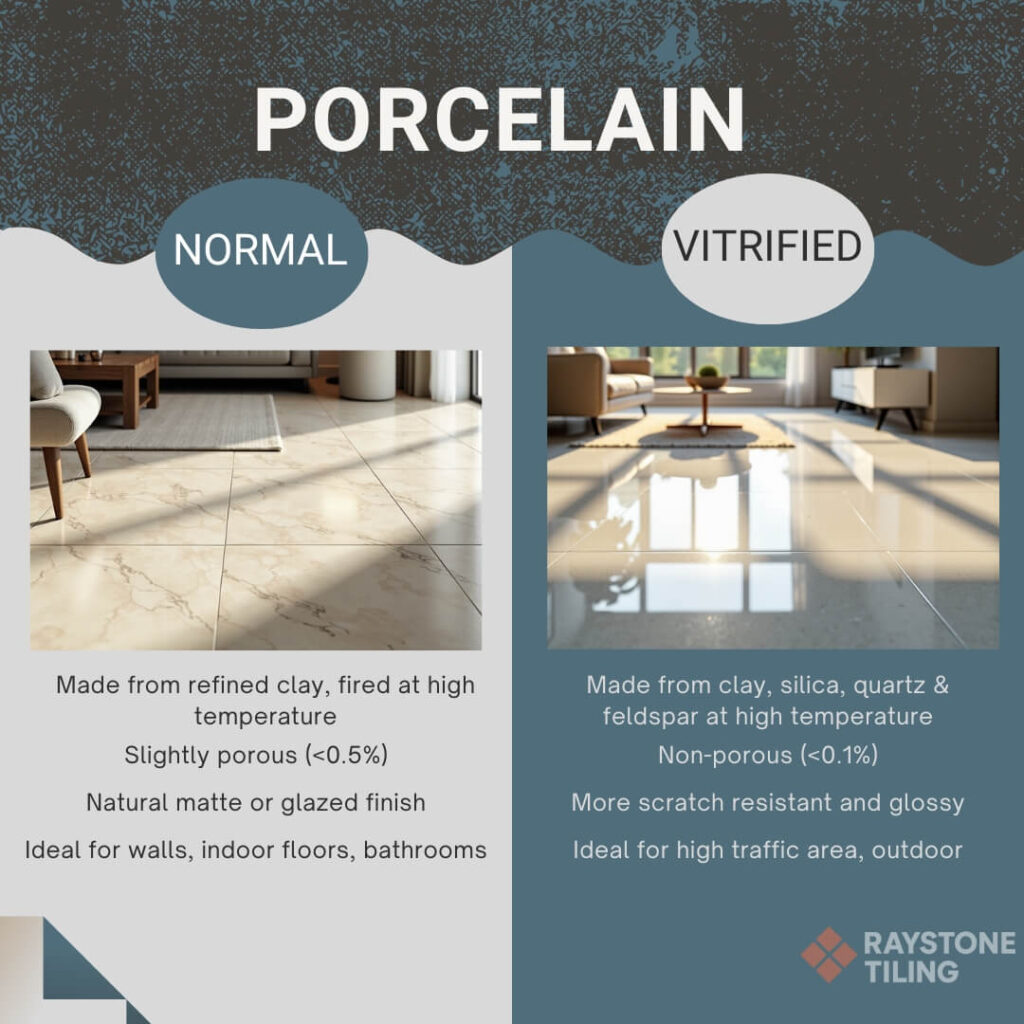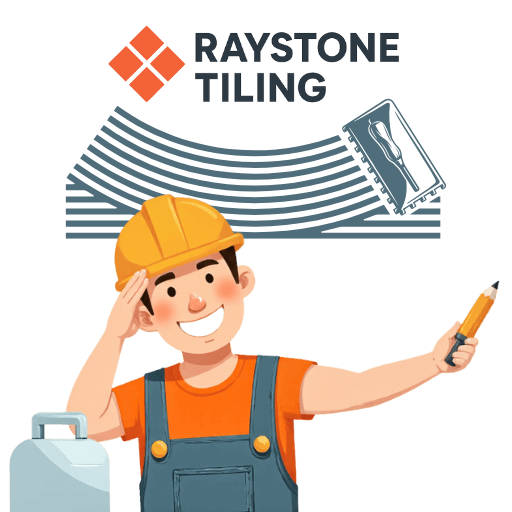Understanding Porcelain and Vitrified Tiles
Waterproof, Durable & Perfect for Modern Flooring?


1. What is self levelling compound and what is it used for?
Vitrified porcelain refers to porcelain tiles that have undergone a vitrification process — a method that makes them denser, harder, and less porous than standard porcelain tiles.
The term “vitrified” comes from “vitrify”, meaning “to turn into glass” – hence the mirror like look.

During firing, the mix of clay, silica, feldspar, and quartz melts slightly, and the materials bond/fuse together to form a glass like structure inside the tile.
This process fills microscopic pores, creating an extremely compact, glossy (reflective), and water resistant surface – it’s simply a porcelain variant.
Different materials melting and fusing is what makes vitrified porcelain special.
2. Types of Vitrified Porcelain Tiles

| Type | Description |
|---|---|
| Full Body Vitrified Tiles (FBVT) | Colour and texture run throughout the tile body, so chips are less visible. |
| Double Charged Vitrified Tiles (DCVT) | Two layers of colours/patterns fused during pressing for better durability. |
| Glazed Vitrified Tiles (GVT) | Have a decorative glaze layer on top, allowing patterns, textures, and digital prints. |
| Polished Glazed Vitrified Tiles (PGVT) | Same as GVT, but with a polished mirror finish for extra shine. |
3. Difference Between Porcelain tiles and Vitrified Tiles
| Feature | Porcelain Tiles | Vitrified Tiles |
|---|---|---|
| Water Absorption | Low — below 0.5% | Very low — below 0.1%, making them nearly waterproof |
| Durability | Highly durable, indoor use | Extremely durable, high frost resistance, outdoor use or high traffic |
| Finish Options | Matte, glossy, or glazed (with a top coated layer) | Full-body (colour runs through entire tile - no top layer), double-charged (fused), glazed (top layer), or polished glazed finishes |
| Scratch Resistance | Good; may show wear over time on glossy surfaces | Excellent; denser body offers better scratch resistance |
| Colour Consistency | Surface colour; chips may reveal lighter base underneath | Full-body and double-charged types maintain colour through the body |
| Cost | More affordable | More expensive due to manufacturing costs |
| Maintenance | Easy to clean; glaze resists stains | Very low maintenance. Need for polishing for mirror look |
Double charged & Glazed look the same?
Double charged tiles (two part fused) look like glazed (coated) tiles but are tougher and chip less because their colour and pattern go deeper into the tile due to fusing. So, if you chip glazed tile you will see clay base.
4. Best Places to Use Porcelain and Vitrified Tiles for when Tiling Floors
| Porcelain Tiles — Best For | Vitrified Tiles — Best For |
|---|---|
| Bathrooms & Wet Rooms – low water absorption, slip-resistant matte options. | Museums, Malls & Airports – extremely durable for high foot traffic. |
| Kitchens – easy to clean, if glazed stain-resistant | Entrance Halls & Corridors – doesn't wear off and scratch resistant |
| Indoor Floors – elegant finish and warm look. | Patios & Outdoor Spaces – low porosity and weather-resistant. |
| Feature Walls – glazed porcelain perfect for decorative designs. | Commercial Floors & Showrooms |
| Living Rooms & Hallways – stylish, cost-effective, and versatile. | Open Plan Living Areas – glossy PGVT tiles for modern spaces. |
Happy Tiling!

Frequently Asked Questions — Porcelain & Vitrified Tiles
Which is better for floors porcelain or vitrified tiles?
Standard porcelain is good for indoors floor tiling, but vitrified tiles are better in high-traffic areas like halls and outside projects due to extra durability and water resistance.
Are vitrified tiles more waterproof than porcelain tiles?
Yes.
Normal porcelain tiles absorb less than 0.5% water that’s good enough for bathroom. However, vitrified porcelain is at least 5x less porous (great for outdoor).
Do porcelain and vitrified tiles need sealing for waterproofing?
Tiles don’t need sealing — but the subfloor or wall behind them does, especially in places like bathroom or wet room.
What are full body vitrified tiles and how are they different from glazed tiles?
Full Body Vitrified Tiles (FBVT) – have colour and pattern running through the entire tile thickness, so chips are less visible – so if it chips it’s the same thing under.
Glazed tiles – have a decorative glass like top layer (glaze) and the colour, texture and design is sort of “printed” to it – so, if you chip the glaze, you will see different texture under.
What does double charged vitrified tile mean?
Double Charged Vitrified Tiles (DCVT) – has two layers. Top layer contains colour and patterns. Bottom is made out of vitrified porcelain material (~90% of tile thickness). So, you might think the top layer is glazed (coated), but that’s not true — the two layers are fused together for greater durability, resulting in a tile that chips less easily.
Are glazed porcelain tiles slippery when wet?
Glossy glazed porcelain tiles can be slippery when wet.
You could choose matte or anti slip finishes (look for high slip resistance rating R10–R12).
Which is more expensive - vitrified tiles or porcelain tiles?
The purpose of vitrified tiles is to be more durable. Hence, they are more expensive than regular porcelain tiles.
Can porcelain tiles be used outdoors or on patios?
Yes. Use matte or textured porcelain tiles for outdoor areas to improve slip resistance and avoid glossy tile finish.
What is the difference between GVT and PGVT tiles?
GVT (Glazed Vitrified Tile) has a glazed(coated) surface that can display printed designs or textures.
PGVT (Polished Glazed Vitrified Tile) is the same tile but polished after glazing (coating) – to get that more “mirror” reflective finish.
Need a Quote?
Professional tiling services in — Tamworth, Lichfield, Sutton Coldfield, Nuneaton. New kitchens splashbacks, bathrooms & floor.
Friendly advice and no-obligation quotes.

